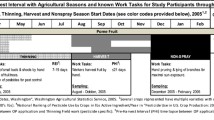Abstract
Five human volunteers entered methyl parathion, ethyl parathion, or monocrotophos treated cotton fields for five-hr exposure periods when the residues of the respective pesticides had aged 12 hr, 24 and 48 hr, and 48 and 72 hr. Foliage residues of methyl parathion disappeared fastest, those of monocrotophos slowest. Personal exposure to pesticide was evaluated from contamination of skin, clothing, and ambient air, while actual absorption of chemical was assessed from pesticide concentration in blood, urinary metabolite excretion, and effects on blood cholinesterase activities. There was good correspondence between magnitudes of foliar residue, estimates of personal contamination, and measures of chemical absorption. Field exposures caused no symptoms or clinical signs of organophosphate poisoning and depressed averaged blood cholinesterase activities by no more than 14% of pre-exposure levels.
Similar content being viewed by others
References
Arterberry, J. D., W. F. Durham, J. W. Elliott, and H. R. Wolfe: Exposure to parathion: Measurement by blood cholinesterase level and urinary p-nitrophenol excretion. Arch. Environ. Hlth.3, 476 (1961).
Bureau of Occupational Health, State of California, Department of Public Health. Diagnosis and Treatment of Phosphate Ester. Pesticide Poisoning: Technical Bulletin for Physicians (1971).
Davies, J. E., J. H. Davis, D. E. Frazier, J. B. Mann, and J. O. Welke: Urinary p-nitrophenol concentrations in acute and chronic parathion exposures. Advances in Chemistry Series No. 60, “Organic Pesticides in the Environment.” Am. Chem. Soc. (1966).
Elliott, J. W., K. C. Walker, A. E. Penick, and W. F. Durham: A sensitive procedure for urinary p-nitrophenol determination as a measure of exposure to parathion. J. Agr. Food. Chem.8, 111 (1960).
Gage, J. C.: The significance of blood cholinesterase activity measurements. Residue Reviews18, 159 (1967).
Hatcher, R. L., and J. S. Wiseman: Epidemiology of pesticide poisoning in the Lower Rio Grande Valley in 1968. Texas Medicine65, 1 (1969).
Linch, A. L.: Biological Monitoring for Industrial Chemical Exposure Control. CRC Press, Inc., Cleveland, Ohio (1974).
Michel, H. O.: An electrometric method for the determination of red blood cell and plasma cholinesterase activity. J. Lab. Clin. Med.34, 1564 (1949).
Rider, J. A., H. C. Moeller, E. J. Pulatti, and J. I. Swader: Toxicity of parathion, systox, octamethyl pyrophosphoramide and methyl parathion in man. Toxicol. Appl. Pharmacol.14, 603 (1969).
Rider, J. A., J. I. Swader, and E. J. Puletti: Anticholinesterase toxicity studies with methyl parathion, guthion, and phosdrin in human subjects. Federation Proceedings30, Mar.–Apr. (1971).
Shafik, T., D. E. Bradway, H. F. Enos, and A. R. Yobs: Human exposure to organophosphate pesticides. A modified procedure for the GLC analysis of alkyl phosphate metabolites in urine. J. Agr. Food Chem.21, 625 (1973a).
Shafik, T., H. C. Sullivan, and H. R. Enos: Multi residue procedure for halo- and nitrophenols. Measurement of exposure to biodegradable pesticides yielding these compounds as metabolites. J. Agr. Food Chem.21, 295 (1973b).
Ware, G. W., D. P. Morgan, B. J. Estesen, W. P. Cahill, and D. M. Whitacre: Establishment of reentry intervals for organophosphate-treated cotton fields based on human data: I. Ethyland methyl parathion. Arch. Environ. Contam. Toxicol.1, 48 (1973).
Ware, G. W., D. P. Morgan, Betty J. Estesen, and W. P. Cahill: Establishment of reentry intervals for organophosphate-treated cotton fields based on human data: II. Azodrin, ethyland methyl parathion. Arch. Environ. Contam. Toxicol.2, 117 (1974a).
Ware, G. W., B. J. Estesen and W. P. Cahill: Dislodgable leaf residues of insecticides on cotton. Bull. Environ. Contam. Toxicol.11, 434 (1974b).
Author information
Authors and Affiliations
Additional information
Contribution to Regional Project W-45, “Residues of Selected Pesticides and Related Chemicals in the Agricultural Environment—Their Nature, Distribution, Persistence, and Toxicological Implications.” University of Arizona Agricultural Experiment Station #2281.
Rights and permissions
About this article
Cite this article
Ware, G.W., Morgan, D.P., Estesen, B.J. et al. Establishment of reentry intervals for organophosphate-treated cotton fields based on human data: III. 12 to 72 hours post-treatment exposure to monocrotophos, ethyl- and methyl parathion. Arch. Environ. Contam. Toxicol. 3, 289–306 (1975). https://doi.org/10.1007/BF02220742
Received:
Accepted:
Issue Date:
DOI: https://doi.org/10.1007/BF02220742




